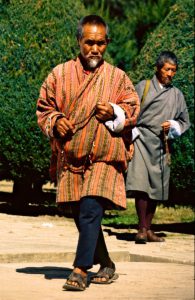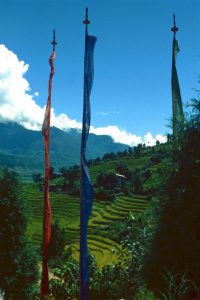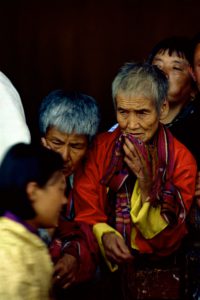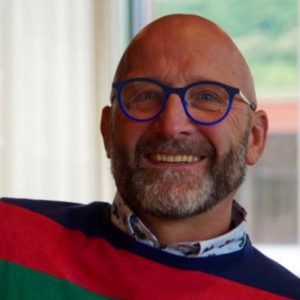The quest for a thunder dragon and golden pagodas
(Walking over two paths to enlightenment)
The first path, Bhutan
The Druk Air flight from Kathmandu to Paro took about an hour and ended with the most spectacular landing I’ve ever had. The plane followed closely the natural lines of the mountains and as soon as the valley widened it landed smoothly. By looking outside the small window It already became clear to me that Bhutan would become an extraordinary experience. After customs were passed and I picked up my luggage I was welcomed By KT Wangdi, my guide.
We drove to my hotel and from there on I had an overwhelming view of the Paro valley and it’s dzong. The view caused goose bumps and I was overwhelmed with emotions. It was just difficult to understand that I just arrived in the country that inspired my imagination for such a long time. Most likely the Paro valley is the first area where Buddhism was introduced in Bhutan and Bhutan is the only country in the world where Mahayana Buddhism is the official state religion. In the afternoon we visited Paro Dzong, where parts of the movie “Little Buddha” were filmed.
It was even more beautiful than I had thought. The country side was amazing. Everything was so peaceful, so clean. Pine forests around, well kept rice fields, and fantastic traditionally built houses. Most Bhutanese are still dressed in their traditional clothes; man wear a gho and women a kira. Our next stop were the ruins of the Drukyel Dzong and Drukyel village where I witnessed an archery game. Time flew by and we ended the first impressive day with a fantastic Bhutanese meal in a local restaurant.
The next day we went to the Tha Dzong. Originally this was the watchtower overlooking the Paro Dzong but now it has been converted into a super interesting museum. We spent quite some time over there before we continued our journey. The next stop before we traveled to Thimpu was at Dumtse Lhakang, a beautiful decorated chorten. During the 1 1/2 hour drive to Thimpu I was short of eyes watching the surreal scenery around me. Chortens, prayer flags, pristine nature, everything seemed to be so much in balance! I felt like a kind of Alice in Wonderland, still not sure whether it was a dream or not…
In Thimpu, the capital of Bhutan, was also a peaceful atmosphere. Little traffic, beautiful houses, birds singing and no traffic lights. There I met Rinzin and Sonam from Yu-Druk Tours and Travel who had arranged my whole journey in Bhutan. It was great meeting them in person after our numerous e-mails. After lunch we went to Simthoka Dzong where I had the first opportunity to view a dzong from the inside. It was really impressive, young monks were learning in a surely inspiring environment.
Also the next day we stayed in Thimpu. Our first goal was a visit to the Memorial Chorten which was built in memory of the 3rd king. Preparations were going on for Phurpai Drupchen, a yearly ceremony to protect Bhutan for evil spirits and evil. There was an impressive atmosphere around the chorten. Our next stop was the Changangka Lhakang, one of the oldest monasteries in the Thimpu valley. From the telecom tower, high on a hill, we had a breathtaking view of the Thimpu valley and the Trashi Chhoe Dzong, where I would return at the end of my journey to witness the Tshechu, a 3 day festival. Other highlights that afternoon were the Zilluka monastery for nuns, Dechen Phodrank, a monk school where I had a nice encounter with some young monks, and The School of Arts. Also I was able to witness an extremely interesting lecture on Bhutanese history by Dr. John , an American expert on Bhutan.
Our next goal were the Punakha and Wangdue valley. We left Thimpu and after a short ride we arrived at the Dochu La pass at 3.050 meter altitude. The pass was covered in mist which made our stay even more special. A small chorten and thousands of prayer flags created a mythical atmosphere.
Once beyond the pass the vegetation changed drastically. Pine trees made place for oaks and rhododendron. On decent I even saw bamboo and banana trees. Both Punakha and Wangdue are on low altitude so two rice harvests a year a re possible. The Punakha Dzong, built in 1637 at the junction of the Mo and Po river, was impressive. A 180 meter long structure which was an outstanding example of Bhutanese architecture. Close to the dzong was a small market and a beautiful hanging bridge. In the afternoon we visited the Dalo Dzong, which was built high in the mountains overlooking the Punakha valley. Over there I saw monks playing khuru, a kind of long distance darts.
Time was passing by quickly and I could hardly believe this was already the 5th day in Bhutan. In the morning we visited the Wabgdue Phodrang Dzong where the first day of the tshechu was celebrated. A crowd was gathered at the central place in the dzong and watched monks and civilians dancing and singing. People in their best clothes enjoyed the special event. For them it was the highlight of the year, for me pure magic. In front of the dzong was a small market and locals picnicked in the area.
I could have stayed much longer over here but we still had a long way to go as today we would travel to Bhumtang, a valley in central Bhutan. The further we drove, the worse the road conditions. Several landslides made driving almost impossible but thanks to our skilled driver we made it. We crossed the Pele La pass, 3200 meter high, which was also covered in thick layers of mist. Once again the vegetation changed and pine trees covered the slopes. On the way we passed Trongsa Dzong, beautifully located on a mountain slope. In a restaurant over watching the dzong we had a fantastic lunch before we continued our journey. We arrived late at night in Bhumtang. We stayed in the Swiss guesthouse with a fantastic homely atmosphere.
Today we would visit several places in the Choskor valley. A lot of people in this area are of Tibetan origin who blended in perfectly in the Bhutanese society. Our first stop was the Jakar Dzong. From there we went to Jambey Lhakang, one of the 108 temples built in the 7th century by king Songtsen Gampo all over Tibet and Bhutan.
The absolute highlight for me was Kurje Lhakang, one of the holiest places in Bhutan where Guru Rimpoche has meditated and left a body imprint in the rocks. Over here Buddhism was introduced when Guru Rimpoche appeared in his 8 manifestations and defeated a bad spirit who was bothering the king for years. I watched beautiful fresco’s and a cosmic mandala which made a big impression on me. The temple itself was extremely beautiful with thousands of Buddha statues inside. Deeply impressed I left this holy place. Finally we visited Membartsho, the burning lake.
By now it was time to return to Thimpu. The trip took us 10 hours and because I was pretty tired by now from all the impressions I slept the major part of the drive. During a short stop at Wangdue Phodrang I was able to see lots of people at the central town square. The Tshechu was over and everybody was preparing to go home. Thimpu would be my home for the night where we arrived around 7 o’clock in the evening.
My traveling through Bhutan was finished but I would not leave before witnessing one of the major events in the country, the Thimpu Tsechu. This religious festival is held every year in honor of Guru Rimpoche as a memoriam to his good deeds. The festival would take place over three days and full of expectations we went to the Trashi Chhoe Dzong where a large crowd had already gathered. The festival was opened with the world famous Shanag, the black hat dance. 21 dancers entered the square end purified the area before the festival continued. It was magic and in spite of the heat goose bumps were all over my body.
I thoroughly enjoyed watching the people who witnessed the festival and the special atmosphere inside the dzong. Phole Mole, the dance of the noblemen and the ladies was dealing with good and bad but had a very comical character. The crowd was delighted. I particularly liked Dametsi Ngacham, the dance of the Dramaitse drums which showed a vision of a saint from east Bhutan about Guru Rimpoche’s heaven. 12 men with yellow skirts and animal masks celebrated the victory of Buddhism with an enchanting dance.
The second day was opened with a dance called Durdag, the dance of the lords of the cremation grounds. Their mission was to defend a symbolic mandala. Once again this dance was about the victory of good over evil. During the day there were a couple of more dances. Tungam, the dance of the terrifying deities. The dance of the rakshas and finally Raksha Mangcham, the dance of the judgment of the dead. It’s pretty difficult to express my feelings during the day as the whole ceremony appeared to be so surrealistic. I felt like floating in a place of an unearthly beauty. Magic filled the air and time seemed to stand still.
Atsaras, clowns entertained the audience during the intervals between dances and at moments where the dances tended to be a bit monotone. They represent acaryas, religious masters from India, and are the only ones who are allowed to make fun out of religion which is normally treated with highest respect. During the last dance they picked up young children from the audience which were given their name by a high lama who was sitting at the balcony in front of the square.
The third and last day of the tsechu was also the most important one. It was opened with the Ging Dang Tsholing, a dance which once more purified the area before the most important dance of the festival could be performed. After it was finished Guru Tshen Gyed, the dance about the 8 manifestations of Guru Rimpoche started. The square was now the heaven and dancers showed the good deeds of Guru Rimpoche. It was spectacular.
The crowd became really excited when a high lama entered the square, wearing the costume of Guru Rimpoche. After a procession he took place on the balcony in front of the square and once again everybody had the possibility to get blessed by him. The festival was closed with Chhosshey, a religious dance. Still a bit confused by all the things I witnessed the last couple of days we returned to Paro for my last night in Bhutan. Together with Dan, a New Yorker who I met at the festival, and KT we returned to the small restaurant where we had dinner on the day of my arrival. Both Dan and I were not the same people as we were on the day we arrived in Bhutan.
The last morning we still had some time left to get a glimpse of Thakzang Dzong. Unfortunately this dzong was severely damaged during a fire in 1998 so there was no need in going close. Instead we sat on a grass field enjoying the atmosphere and once more I had a very good discussion with KT about Buddhism and the meaning of life. On the way to the airport we stopped at Drongpa Ghoemba where both KT and myself received the blessing of a reincarnation of a high lama. Then it was time to leave… I said goodbye to KT and my driver after which I checked in for the flight to Calcutta and Bangkok. We had a delay of more than two hours because we had to wait until the temperature in the valley dropped a couple of degrees so the plane could get enough uplift. After take off I still had one final glimpse of the Paro valley. The sight was blur though, tears in my eyes made it difficult to get a clear view of the country which I fell totally in love with during the past eleven 11 days.
I would never have been able to experience Bhutan in such an intense way without the outstanding help of Rinzin and Sonam of Yu-Druk Tours and Travel. They organized everything to make my stay an outstanding one. A big “kadinchhey” (thank you) to the both of you.
I met KT as my guide but we said goodbye as friends. During our numerous conversations I got a better understanding of Druk Yul, the land of the thunder dragon and it’s people. He showed me places beyond imagination. It has been an awesome experience. This whole trip has made a big impression on me and I left Bhutan with big respect and a warm feeling in my heart. KT, I hope to meet you again one day! Kadinchhey, legzhembe joen.
Continue the journey in Myanmar
































































































































